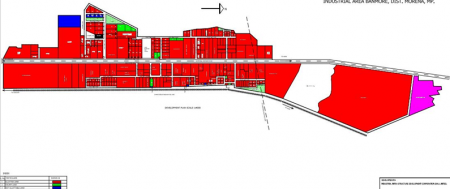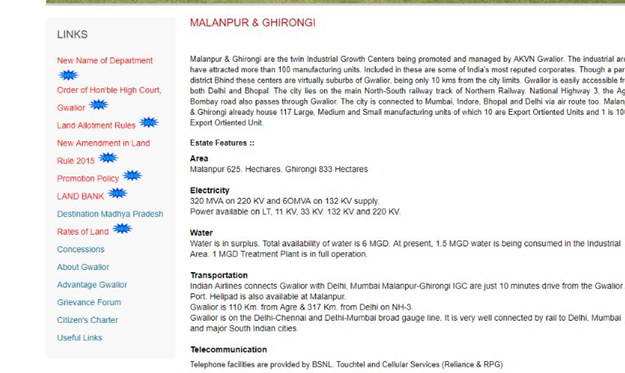Industrial Areas in Chambal Faced BJP Government’s Apathy

Map of Malanpur-Ghirongi Industrial Area
[NewsClick travelled through the Chambal region, one of the most backward regions in Madhya Pradesh, to find out the condition of people and major issues facing them. This is Part 4 of a series of reports from Chambal.]
Gwalior / Bhind / Morena: Madhya Pradesh has a very high rate of unemployment, but even within the state, the Chambal region stands the worst.
The Chambal region which comprises Gwalior, Bhind and Morena, has a total population of around 60 lakh, mostly youths. However, there are no jobs in the region.
As per the Madhya Pradesh state assembly records, on an average, 17,600 jobs have been created every year in the state since the BJP came to power in the state in December 2003. As per the data tabled in the assembly, 2,46,612 jobs were generated in the state between 2004 and 2017. Of these, 2,27,386 jobs came from the private sector.
However, there is no data available which specify the level of unemployment in the Gwalior-Chambal region. The lifelines of the region’s economy—Malanpur and Banmore industrial areas—are doing no better thanks to the previous state government’s policies.
The Initial Boom
Malanpur and Banmore Industrial Area are the two major industrial hubs in Gwalior's proximity. They were set up in 1984 to create jobs, especially in the wake of the closure of JC Mills and Cimmco, a steel moulding factory.
Amid an atmosphere of insecurity created by the rampant menace of dacoities, the then Union minister Madhavrao Scindia had persuaded the industry barons to set up units at Malanpur and Banmore.
Also Read: Not MSP or Development, Stray Cows the Real Problem in Chambal in MP
Entrusting the project under Scindia, the then Congress government gave a 35 per cent subsidy, tax exemption on electricity and water to the companies to attract the investors. Owing to the industry-friendly policies, simplified rules, tax exemptions and connectivity, soon after, this barren stretch of land covering Bhind and Morena districts were transformed into a booming industrial town.

Map of Banmore Industrial Area
In less than a decade, about 275 units were set up at Malanpur Industrial Area (MIA) in Bhind district and 186 units came up at Banmore Industrial Area (BIA) in Morena district. Big companies such as Godrej, Cadbury, Crompton Greaves, JK Tyre, Nova, Sun Pharma and others established units in the region.
BJP Government Ended Subsidies, Created Crisis
However, the initial burst of boom didn't last long. “There are around 60-70 factories including 13 big in Malanpur and around 10 in Banmore, which directly employees around 8,000 - 9,000 people,” said Avinash Mishra, president of MIA industrial association.
Contrary to this data, the official website of the Madhya Pradesh government, the Industrial Infrastructure Development Corporation of Gwalior, M.P. Ltd. (IIDCG) claimed that there are 117 small, medium and large-scale manufacturing units in Malanpur and 82 in Banmore.

Screenshot of IIDCG website listing the number of industries in Malanpur-Ghirongi
Mishra claimed that when he came to Malanpur in 1991, there were 250 factories but since the last two decades, this industrial hub has started going downhill. The reasons are several, but most importantly, the state government ended subsidies and failed to sustain the business-friendly environment. “In addition to this, the issue of land prices going up, water crisis and no benefit from either of the Global Investor Summits conducted by the state government meant that only 60-70 factories are left,” he further said.
Also Read: Why BJP Lost Ground in Madhya Pradesh After 15 Years
“In the beginning, there was a 35 per cent subsidy, which was later trimmed to 15 per cent, but as the Bharatiya Janata Party (BJP) came to power in the state in 2003, the government ended all subsidy and other facilities. The move cast a shadow on both the industrial areas and companies started giving a wide berth to the state,” Mishra told NewsClick.
While the former Sarpanch of the Malanpur area Raghvendra Sharma believes that the fall of both industrial areas started to begin as BJP rose to power in the state. “Besides subsidies and tax, soon after coming to power, the government hiked the price of land in the industrial areas. Today, industries are forced to buy water from Kotwal dam because of the water crisis,” said Sharma.
Industrialists also pointed to alleged bad maintenance of basic infrastructure such as street lights, roads and drainage. Only a few sectors have concrete drains, and the site lacks a common effluent treatment plant. “During monsoons, the effluents spill onto roads,” one of the industrialists pointed out.
The owners of small and medium units complained of long power cuts and others of the absence of cooperation between state departments such as state electricity board and pollution control board.
Also Read: Madhya Pradesh’s 20 MPs Failed to Utilise MPLAD Funds
A senior official from the Banmore Industrial Area association, who did not wish to be named, claimed the poor connectivity of the region as one of the major reasons for the region’s deteriorating condition.
“Air connectivity is very poor from Gwalior to Mumbai and Delhi. Some airlines offer flight services three days in a week to Delhi but no daily or direct flight from Gwalior to Mumbai or Delhi. There are trains for Delhi but they are not suitable for the industrialists,” the official told NewsClick.
General secretary of the MP Chamber of Commerce and Industries, Bhupendra Jain said, "The government should adopt industry-friendly policies and simplify rules, relax taxes and end red tape to allow the industries to grow."
The local industrialists said that Malanpur and Banmore have the potential to develop as a major industrial destination owing to their proximity to Gwalior, which is about 300 km from the national capital. If the state government frames industry-friendly policies and simplifies rules, both the areas can boom again.
“We have high hopes from the current government but how they revamp both the industrial regions, only time will tell,” Mishra said.
Get the latest reports & analysis with people's perspective on Protests, movements & deep analytical videos, discussions of the current affairs in your Telegram app. Subscribe to NewsClick's Telegram channel & get Real-Time updates on stories, as they get published on our website.
























